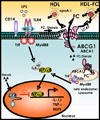Role of HDL, ABCA1, and ABCG1 transporters in cholesterol efflux and immune responses
- PMID: 19797709
- PMCID: PMC2812788
- DOI: 10.1161/ATVBAHA.108.179283
Role of HDL, ABCA1, and ABCG1 transporters in cholesterol efflux and immune responses
Abstract
Atherosclerosis has been characterized as a chronic inflammatory response to cholesterol deposition in arteries, but the mechanisms linking cholesterol accumulation in macrophage foam cells to inflammation are poorly understood. Macrophage cholesterol efflux occurs at all stages of atherosclerosis and protects cells from free cholesterol and oxysterol-induced toxicity. The ATP-binding cassette transporters ABCA1 and ABCG1 are responsible for the major part of macrophage cholesterol efflux to serum or HDL in macrophage foam cells, but other less efficient pathways such as passive efflux are also involved. Recent studies have shown that the sterol efflux activities of ABCA1 and ABCG1 modulate macrophage expression of inflammatory cytokines and chemokines as well as lymphocyte proliferative responses. In macrophages, transporter deficiency causes increased signaling via various Toll-like receptors including TLR4. These studies have shown that the traditional roles of HDL and ABC transporters in cholesterol efflux and reverse cholesterol transport are mechanistically linked to antiinflammatory and immunosuppressive functions of HDL. The underlying mechanisms may involve modulation of sterol levels and lipid organization in cell membranes.
Figures

References
-
- Tall AR. Cholesterol efflux pathways and other potential mechanisms involved in the athero-protective effect of high density lipoproteins. J Intern Med. 2008;263:256–273. - PubMed
-
- Rader DJ. Mechanisms of disease: HDL metabolism as a target for novel therapies. Nat Clin Pract Cardiovasc Med. 2007;4:102–109. - PubMed
-
- Tabas I. Consequences and therapeutic implications of macrophage apoptosis in atherosclerosis: the importance of lesion stage and phagocytic efficiency. Arterioscler Thromb Vasc Biol. 2005;25:2255–2264. - PubMed
-
- Tall AR, Yvan-Charvet L, Terasaka N, Pagler T, Wang N. HDL, ABC transporters, and cholesterol efflux: implications for the treatment of atherosclerosis. Cell Metab. 2008;7:365–375. - PubMed
Publication types
MeSH terms
Substances
Grants and funding
LinkOut - more resources
Full Text Sources
Other Literature Sources
Medical

